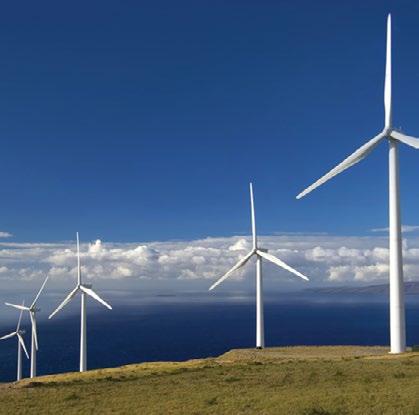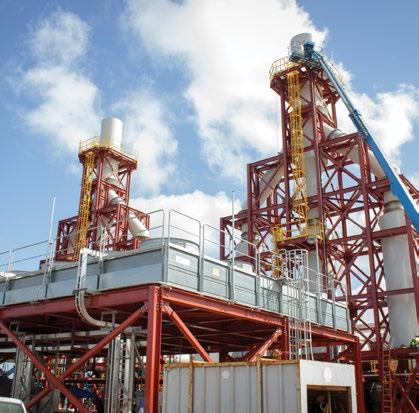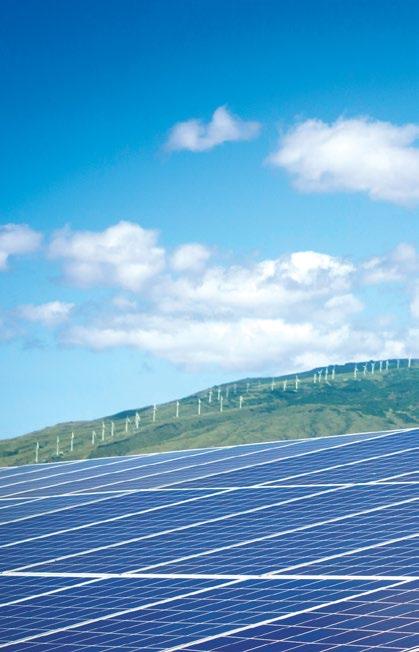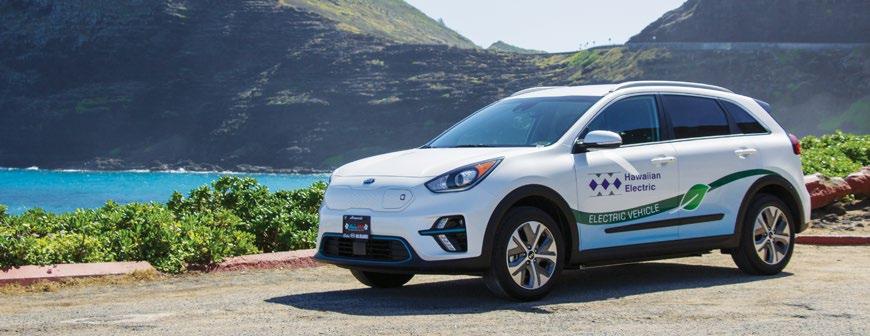
33 minute read
TCFD Disclosures
At HEI we have committed to implementing the recommendations of the TCFD in full over time. In this, our first TCFD- aligned disclosure, we outline our governance and risk management approach for climate change, identify key climate-related risks and opportunities, provide a high-level analysis of implications of a transition climate scenario and a physical scenario, and summarize our current primary metrics and targets related to climate change.
Advertisement
We intend to enhance our TCFD reporting going forward. A key element is aligning our TCFD scenario analysis with our utility’s Integrated Grid Planning (IGP) process, a long-range planning process currently underway to determine our utility generation, transmission and distribution needs to achieve our state climate goals and enhance resilience.
Governance & Risk Management
What is Our Approach for Governance of Climate-Related Risks and Opportunities?
We believe ESG-related risks, opportunities and strategies, including those related to climate change, have the same potential to impact long-term value as other significant risks and opportunities. As a result, the Board and management determined that all material ESG factors should be identified and formally integrated into our existing governance structures and management activities.
1 2 3 4 5 6 7
Four Elements of Recommended Climate-Related Financial Disclosures
Governance
Strategy
Risk Management
Metrics and Targets
Governance
The organization's governance around climate-related risks and opportunities
Strategy
The actual and potential impacts of climate-related risks and opportunities on the organization's business, strategy and financial planning
Risk Management
The processes used by the organization to identify, assess and manage climate-related risks
Metrics and Targets
The metrics and targets used to assess and manage relevant climate-related risks and opportunities
Source: TCFD, "Implementing the Recommendations of the Task Force on Climate-Related Financial Disclosures" (June 2017)
In addition, the Board and its NCG Committee deliberately work to ensure we have directors with highly relevant experience on ESG topics applicable to our businesses and strategies, including renewable energy, climate change strategy, environmental management and sustainable investing. Seven independent members of the Board have direct experience in one or more of these areas, bringing deep expertise to the Board’s oversight of climate-related risks and opportunities. See page 15 for additional details on board expertise.
Company strategies are overseen by the Board as a whole and are managed through HEI’s strategic planning processes. The Board provides guidance on strategic priorities and plans and approves the overall corporate budget to allocate resources for agreed-upon strategies. The Board carries out these responsibilities through its annual strategic retreat, regular Board meetings, review of written reports and ongoing engagement with management. Climate-related matters have been an increasingly important focus of management and the Board and have become a key component of our long-term business and operational planning processes.
Many of our strategies, plans and investments relate to reducing the severity of climate change in the future through decarbonization, such as the utility’s work to retire fossil fuelbased generation and increase the use of renewable energy and storage and the utility’s and Pacific Current’s efforts to increase electrification of Hawai‘i’s economy, including transportation. We also have set into motion strategies, programs and plans to prepare our companies to withstand future impacts of climate change and improve the resilience of our infrastructure and operational capabilities and processes. This includes investments like our Schofield Generating Station, which enhances resilience through its location away from the shoreline, its quick-starting capability to respond to fluctuations in solar and wind generation and its ability to use biofuels or conventional fuels. We also regularly monitor and make other investments to increase the reliability of our island power grids.
The Board, along with the operating company boards of Hawaiian Electric and American Savings Bank, are involved in frequent discussions of and receive regular reports on climaterelated strategic matters. Such discussions and reports have included:
Annual review of company strategy and enterprise risk at board strategy retreats:
the 2019 retreat included a “deep dive” on climate change risk and sea level rise, and included presentations by climate risk analytics firm Jupiter
Intelligence and by each operating company on climate-related risks and mitigation plans
the 2020 retreat included an update on the integration of material ESG elements, including climate change, into risk management and strategic planning
Quarterly review of progress on strategic initiatives as part of regular board meetings
Monthly updates on Hawaiian Electric’s progress on initiatives to achieve Hawai‘i RPS goals
Board member involvement in considering climate scenarios and climate-related risks and opportunities in preparing for this initial TCFD-aligned report
Climate-related risks are integrated into HEI’s overall Enterprise Risk Management (ERM) processes. The Board provides oversight of climate-related and other risks through comprehensive and integrated ERM processes and regular reporting on the material risks that can potentially impact our operations, strategies and long-term financial performance. The Board also reviews and provides feedback on the company’s ERM processes for identifying, monitoring, managing and mitigating risks to ensure these processes are effective. Topics discussed at the board level include utility reliability and resilience, technology innovation and integration, increased frequency of natural disasters and extreme weather events and their potential impacts for our companies, sea-level rise and its potential implications for physical assets and financial assets such as the bank’s loan portfolio, and land use and community sentiment in the context of accelerated renewable energy development.
Each Board committee has responsibilities with respect to oversight of climate-related risks and opportunities, and reports on its activities and recommendations through our regular and, as necessary, special Board and/or committee meetings:
The Nominating & Corporate Governance Committee (NCG Committee) is responsible for ensuring all material ESG issues, including climate-related risks and opportunities, have appropriate Board oversight.
The Audit & Risk Committee is responsible for overseeing (i) the ERM program, which includes management of climate-related risks and (ii) financial and other reporting to ensure transparency and consistency with best practices and standards.
The Compensation Committee oversees executive compensation, including establishing incentive goals to drive execution of strategy. Several ESG goals, including climate change-related goals, are included in executive incentive compensation for HEI and utility executives. This includes existing goals for accelerating RPS achievement and improving reliability, and newly added goals in 2021 relating to electrification of transportation (EOT) and performancebased regulation (PBR).
In addition to the Board committees, committees of the independent boards at each of the utility and bank subsidiaries assist with oversight of risks, including climaterelated risks. The Hawaiian Electric Audit & Risk Committee assists in overseeing the utility ERM program and the ASB
Risk Committee assists in overseeing the bank’s ERM program.
What is the Oversight Process for Climate-Related Risks and Opportunities?
The Board has approved a consolidated ERM system recommended by management. The system is designed to identify and assess risks across the HEI enterprise so that information regarding the enterprise risks can be reported to the Board, along with proposed strategies for mitigating and managing these risks. The structure of the ERM system is decentralized, with separate chief risk officers at each of Hawaiian Electric and ASB in addition to HEI's chief risk officer (HEI CRO). The ERM functions for "other" operations of HEI, such as Pacific Current, are performed by the HEI CRO or HEI employees under the supervision of the HEI CRO. Each subsidiary chief risk officer reports directly to the respective subsidiary president and functionally to the HEI CRO, who reviews such risks on a consolidated basis. The Board believes that this decentralized risk management structure is appropriate and effective for the Company’s diverse operations and holding company structure, because it allows for industry-specific risk identification and management at the subsidiary levels while also ensuring an integrated and consolidated view of risk at the holding company level.
Business and strategic planning are designed to develop goals and priorities, establish key performance indicators and identify challenges to successfully implementing company strategy. Management hosts and actively participates in an annual multiday strategy retreat with the Board, where plans and strategic initiatives across the HEI enterprise are reviewed, providing the basis for the annual budgeting process and update to our multiyear financial forecast. Strategies and progress updates toward achieving key goals, such as the RPS, are discussed with the Board in depth at the retreat, as well as through Board meetings over the course of the year. On an ongoing basis, management plans and executes strategies to achieve organizational priorities, including ESG responsibilities and initiatives.
Future Intent
As the climate change landscape evolves, we will continue to build upon the strong base level of experience and knowledge within senior management and the Board, as well as continue to consider climate change expertise in Board succession planning. The full Board will continue to monitor our sustainability performance and approve updates to our sustainability strategy and goals.
RISK THEMES
Physical
Technology
Market
Policy & Legal
Reputation

Strategy
1 2 3 4 5 6 7
What Climate-Related Risks and Opportunities has HEI Identified Over the Short, Medium and Long Term?
HEI defines risk as uncertainty that could have an adverse effect leading to financial, physical and/or reputational loss, harm and/or damage. Opportunities arise when conditions, trends and/or company strengths present the potential to generate financial or other benefits. In preparation for this report, risks and opportunities were considered for three time horizons – short term (<5 years), medium term (5-15 years) and long term (15+ years).
In line with TCFD recommendations, HEI categorized risks into five themes: “Physical,” “Technology,” “Market,” “Policy & Legal” and “Reputation.”
RISK THEME DESCRIPTIONS
THEME
PHYSICAL
TECHNOLOGY
MARKET
POLICY & LEGAL
REPUTATION
DESCRIPTION
The risks posed to operations and assets by climate change. Physical risks originating from climate change can be eventdriven (acute) such as increased severity of extreme weather events (e.g., hurricanes, droughts, floods and fires). They can also relate to longer-term (chronic) shifts, such as increases in precipitation and temperature, greater variability in weather patterns and sea level rise.
The risks associated with the substitution of existing products and services with lower emission options, unsuccessful investment in new technologies and costs to transition to lower emissions technology.
The risks associated with a significant change in consumer behavior and expectations, with consumers seeking new, enhanced and/or innovative goods and services, which may include low-carbon energy solutions and digitalized services.
The risks associated with legislative and regulatory actions to reduce carbon emissions (such as acceleration of energy transition requirements, pricing of GHG emissions, enhanced emissions reporting obligations, mandates on and regulation of existing products and services or new product development) and exposure to litigation.
The risks arising from stakeholders’ expectations of how businesses respond to climate change issues. Risks in this area can lead to loss of revenue or market share if these expectations are not addressed.
Examples of risks identified through HEI’s physical climate risk assessment are provided below and categorized by risk theme and timing:
0 Short Term
<5 yrs
5 Years
TIMELINE HORIZON
Medium Term
5-15 yrs
Long Term
15+ yrs
15 Years
RISK TIMELINE
THEME
PHYSICAL
TECHNOLOGY
MARKET
POLICY & LEGAL
REPUTATION
RISK NAME
Flooding (Acute)
Sea level rise (Chronic)
Increased frequency of intense / severe storms (Chronic)
Reliability
System resilience
Unsuccessful investment in new technologies
Affordability
Increased cost of raw material and key inputs
Change in customer behavior / expectations
Negative impacts to state’s economy
Managing public and regulatory expectations / perceptions
GHG emissions pricing
Increased stakeholder concern TIMELINE
Short term
Medium term
Medium term
Short term
Short term
Medium term
Short term
Short term
Short term
Medium term
Short term
Short term
Short term
OPPORTUNITY THEME DESCRIPTIONS
THEME DESCRIPTION
ENERGY SOURCE
RESOURCE EFFICIENCY
These opportunities are typically associated with the utilization of lower emission sources of energy, supportive policy incentives and new technologies.
These opportunities relate to more efficient energy production and distribution and modes of transportation, increased efficiency in buildings (including water, energy and cooling/heating needs) and the reduction of water usage and consumption.
PRODUCTS & SERVICES These opportunities refer to the development and/or expanding use of goods and services with lower emissions, development of climate adaptation and solutions and development of new products or services.
MARKETS
RESILIENCE
These opportunities relate to expansion of and access to new markets, supporting and facilitating the integration of new low-carbon and climate adaptation technologies, products and services by both banking and utility customers, as well as the use of public sector incentives to enable more timely and efficient energy transition and climate adaptation.
These opportunities refer to improvement of system resilience and reliability, e.g., through resource and/or geographic diversification, system hardening, deployment of new technologies and customer participation in new renewable energy programs.
OPPORTUNITY TIMELINE
THEME
ENERGY SOURCE
RESOURCE EFFICIENCY
PRODUCTS & SERVICES
MARKET
RESILIENCE
OPPORTUNITY NAME
Increased use of renewable energy sources
Growth of decentralized / distributed generation and grid services
Electrification of transportation and other sectors TIMELINE
Short term
Short term
Short term
More efficient transmission and distribution system and operations Short term
Shift in customer preferences creating opportunities for new energy products Short term
Financing physical relocation or reinforcement of properties Short term
Financing the renewable energy transition
Water / wastewater management
Affordable housing
Local catalyst for change
Sustainable / affordable / resilient community (re-)development
Diversification of geography (e.g., siting of infrastructure at higher elevations and/or other islands within the state) Short term
Short term
Short term
Short term
Medium term
Short to medium term
What is the Impact of Climate-Related Risks and Opportunities on HEI’s Businesses, Strategy and Financial Planning?
HEI sees climate change as a significant challenge facing its future operations, presenting a range of risks as well as meaningful opportunities. Given the unique factors of being in remote island communities, we see many of the climate-related risks – and our need to address them – as beginning in the near term. We also see many of our opportunities as presenting themselves in the near term. The paragraphs that follow discuss key risks and opportunities related to climate change that we’re addressing and factoring into our strategies and plans.
Risks
1 2 3 4 7
Climate change has the potential to increase the severity and frequency of hurricanes, flooding and droughts in Hawai‘i and is expected to lead to rising temperatures and increasing sea level rise in the state. If not appropriately planned for and addressed, these physical climate change impacts could cause damage to (i) Hawaiian Electric facilities, impacting operations and reliability, (ii) the properties that secure American Savings Bank’s residential and commercial loans, impacting the value of that collateral and (iii) the state’s economic health, affecting the financial health of our customer base. We’re focused on managing and mitigating physical risks to our operations from climate change and are leaders in community planning initiatives to promote broader resilience in the state. The utility is developing a robust approach to assessing resilience threats and prioritizing improvements to enhance resilience. This has included an independent review of potential resilience vulnerabilities, using climate risk analytics to refine and prioritize specific needs engaging with stakeholders to understand and incorporate their perspectives. We’re building these considerations into our Integrated Grid Planning (IGP) process, which is our in-progress planning effort to determine future generation, transmission and distribution needs for our system.
The utility engaged Exponent, a leading consulting firm in electric utility resilience, to perform an independent assessment to identify key vulnerabilities to severe natural events. Following this assessment, Exponent outlined a set of recommendations to ensure quick restoration of critical customers, reduce total restoration time and minimize the total amount of damage from a severe natural event. This included recommendations for system hardening, substation flood monitoring, enhanced vegetation management, emergency restoration, damage prediction modeling and additional in-depth studies. The utility is currently developing work plans based on Exponent’s recommendations, climate risk analysis and ongoing IGP efforts.
The utility engaged Jupiter Intelligence, a leading provider of predictive climate risk data and analytics, to provide climate risk analysis for its generation, transmission and distribution infrastructure. This climate risk analyses will inform decisions about the location, prioritization and timing of investments to provide the electric system resilience that customers and regulators expect.
The utility is using the Exponent and Jupiter Intelligence analyses to inform its IGP process and planning. The
IGP process also includes a Resilience Working Group composed of stakeholders representing critical infrastructure providers, emergency management agencies, state and local government energy, planning, climate change and resilience officials, the hospitality and healthcare industries, the military, solar and other renewable energy providers and other stakeholders.
In parallel, the utility continues to focus on strengthening its emergency response capabilities through management training and development, as well as by engaging with community leaders and stakeholders to strengthen broader community resilience. See page 67 for more on our work to advance community resilience.
As the utility adopts and procures new technology and solutions to increase clean energy and meet customers’ evolving expectations, there is a risk of locking in long-term infrastructure or contractual commitments that become overtaken by more


efficient or more economic options. One of the utility’s core planning principles is to not let today’s technology crowd out tomorrow’s breakthroughs. The utility carefully assesses new technologies and closely monitors developing technologies and cost curves before investing in or contracting for new generation capacity or other resources.
Policies enacted at the national, state or local level to limit climate change or its physical impacts could, depending on their design, adversely impact cost of living in Hawai‘i, which has the highest cost of living in the nation (see page 19). Such policies may include a carbon tax, which may impact customers in the form of higher rates. Carbon pricing or taxes may also accelerate procurements of renewable resources, which, as noted above, could result in locking in higher prices before better or lower cost options are available, and thereby increase the total cost of the renewable transition. Other types of policies may involve increased federal and state taxes to fund governmental infrastructure hardening/relocation or other resilience programs.
American Savings Bank regularly monitors its credit exposure in areas at risk of sea-level rise and increased exposure to climaterelated weather events. Its appraisal team performs property research to confirm flood zones, and its underwriting decisions evaluate flood zone maps, which consider property location, topography and elevation. The bank requires borrowers with property in a Special Flood Hazard Area, as defined by the Federal Emergency Management Agency (FEMA), to maintain sufficient flood insurance throughout the life of the loan. Should Special Flood Hazard Areas change due to sea-level rise, the bank may require affected borrowers to obtain flood insurance. The bank monitors leading indicators to assess how and when market valuations may reflect potential future climate change impacts and discusses such indicators and any mitigation recommendations with the ASB Risk Committee, HEI CRO and HEI Audit & Risk Committee.
The bank also considers and plans for other physical risks related to climate change, such as the potential for business interruption due to severe weather. To promote resilience and continued customer service, the bank’s core processing is located on the U.S. mainland with back-ups in several different U.S. states. This geographic diversification supports the bank’s ability to serve its customers even in the event of severe storms, flooding or other acute events impacting Hawai‘i.
The health of HEI as a consolidated enterprise is inextricably linked to the strength of the local economy, community and environment of our state. Adverse climate-related changes in Hawai‘i could impact the state’s environmental and cultural assets and its appeal as a visitor destination and place to live. Adverse climate change impacts on the U.S. mainland could reduce the market for travel to Hawai‘i. Such conditions could negatively impact HEI’s businesses to the extent they affect the state’s tourism sector, currently the largest driver of Hawai‘i’s economy, or decisions by Hawai‘i businesses and families to relocate out of state. Examples include warmer temperatures; warmer oceans that stress coral reefs and sea life, potentially reducing the abundance and variety of marine life; and sea-level rise and coastal erosion, which could adversely impact the state’s beaches and near-shore infrastructure, homes and businesses.
Opportunities
1 2 3 4 5 6 7
While climate change presents significant risks, it also offers meaningful opportunities for HEI and its subsidiaries. As the state of Hawai‘i strives to transition to a carbon neutral to carbon negative economy and continues one of the nation’s most ambitious energy transformations, our companies have opportunities to invest in decarbonization and resilience, advance electrification of our economy to benefit all customers, offer new products and services, and partner with our communities to advance a more sustainable future for Hawai‘i.
Hawaiian Electric Climate Change Opportunities


Adding hundreds of megawatts of renewable energy to our system and retiring fossil fuel-based generation to reduce carbon emissions, increase energy independence and promote customer bill stability
Incorporating battery storage to help integrate increasing amounts of intermittent renewable energy such as solar or wind resources
Creating opportunities for customers to benefit from and participate in the clean energy transition by providing programs and rate structures to integrate customer-owned distributed energy resources (DERs)
Expanding access to clean energy benefits through our community based renewable energy (community solar) program, enabling customers without the ability to add private rooftop solar, as well as qualified low- to moderateincome (LMI) customers, to participate in the clean energy transition and benefit from bill credits
Enabling the use of customer DERs to provide grid services, supporting reliable grid operations and responding to variability in electricity supply and demand
Advancing opportunities to electrify the state’s economy, including the transportation sector and thus reducing
Hawai‘i’s overall carbon emissions; this includes deploying utility-owned fast chargers, proposing make-ready infrastructure to support electric buses and fleets, providing educational resources to help overcome barriers to electric vehicle adoption, and collaborating with stakeholders to further advance electrification
Modernizing our grid to facilitate increased integration of clean energy and distributed resources, greater efficiency, resilience, improved reliability and more customer options
Enhancing the resilience of our system through partnering with key customers, including the military, to develop resilient generation and microgrids that can be isolated from the grid when needed; hardening or reinforcing critical transmission circuits; locating equipment outside areas prone to flooding; and considering alternative paths for transmission circuits to increase geographic diversity
Evaluating opportunities to partner with different industries, such as agriculture, to help diversify Hawai‘i’s economy while leveraging clean energy
American Savings Bank Climate Change Opportunities
As businesses and consumers throughout the Hawai‘i economy work to reduce their carbon emissions and increase their resilience to climate change impacts, the bank has opportunities to finance customer investments in energy efficiency, renewable energy, storage, electric vehicles and resilience.
The bank also has opportunities to participate in tax credit programs, such as New Markets Tax Credits (NMTC), to help fund renewable energy and other projects in disadvantaged communities. Through a Hawai‘i-based community development entity formed in partnership with the O‘ahu
Economic Development Board, the bank has helped deploy over $100 million in NMTCs and plans to apply for future allocations. These allocations help bring new investments, services and jobs to some of the most underserved, low-income communities in our state, and include direct investment in renewable energy projects as part of our state’s clean energy transition.
Climate change also presents opportunities for the bank to deepen customer relationships by offering educational resources to help them plan for climate change impacts, such as sea-level rise or increased severity of storms, to their homes and businesses.
The bank has taken significant steps to enhance the energy and water efficiency of its real estate, and has also reduced its physical footprint in recent years through back-office and branch consolidations. The bank has also incentivized employees to use low-carbon transportation options by offering a green transportation benefit. These efforts help reduce the bank’s overall carbon footprint and contribute to its cost efficiency. As the bank continues to upgrade its facilities and transition to mobile- and technology-enabled
“Anytime, Anywhere Banking,” it will reduce its reliance on its physical retail branch network and have additional opportunities to increase resource efficiency.
The bank also has opportunities to finance the development of sustainable, affordable and workforce housing. Such housing can be equipped with features such as solar water heating, solar plus battery storage and efficient water and water re-use systems. These projects present the potential for the bank and Pacific Current to partner to offer these solutions.
Pacific Current Climate Change Opportunities
Opportunities to invest in customer-sited and utility scale renewable energy projects supporting the transition to clean energy
Expanding deployment of EverCharge Hawai‘i charging infrastructure to provide affordable charging systems that optimize existing infrastructure
Exploring market-based business models to scale up reforestation, conservation, and carbon sequestration solutions, potentially in conjunction with renewable energy and agriculture
Partnering with water reuse and wastewater treatment technology providers to evaluate opportunities to deploy distributed wastewater treatment solutions that enable water reuse and production of renewable natural gas

What is the Potential Impact of Different Scenarios, Including a 2°C Scenario, for HEI?
In preparing for this report, we conducted a high-level scenario analysis to assess the impact on our business, strategy, and financial planning of certain climate scenarios. To inform our analysis of potential risks and opportunities, we selected one transition scenario, the International Energy Agency’s Energy Technology Perspectives (ETP) 2ºC Scenario, and one physical scenario, the Intergovernmental Panel on Climate Change’s (IPCC) Representative Concentration Pathways (RCP) 6.0.
Transition Scenario
We selected the ETP 2ºC Scenario as it (i) recognizes the importance of decarbonizing economic sectors beyond electricity to limit global temperature rise to below 2°C and (ii) highlights the role of the electricity sector in enabling broader economy decarbonization.
The ETP 2ºC Scenario assumes a transformation of energy generation and consumption to yield a broad reduction in carbon emissions across energy generation, transportation, industry, and buildings. Under this scenario, significant increases in renewable electricity generation enable decarbonization of other sectors. As more companies and sectors electrify, electricity consumption is expected to grow significantly. The scenario assumes renewable energy generation, process electrification, and other technologies, such as carbon capture, utilization and storage (CCUS) and low-carbon fuels needed to effectuate carbon reductions, are commercially available or sufficiently advanced in their development lifecycle. Policymakers will have a critical role in enabling the transition, including through policies to incentivize investment in new technologies and in electrification of the transport, industry, and building sectors.
There is growing ambition among policymakers and others to limit global temperature rise to 1.5ºC. While we used a 2ºC scenario as our base transition scenario, part of the rationale for selecting the ETP scenario was its inclusion of a “Faster Innovation Case,” an accelerated version of the scenario focused on achieving a 1.5ºC target by 2050. To achieve this, the world would need to reach net-zero emissions by 2050, requiring more rapid deployment of renewable generation and faster development of solutions to electrify broader swaths of the economy.
For our companies, the transition under the Faster Innovation Case would accelerate the transition impacts described above. Such an acceleration could cause the transition to be more costly, as it would leave less time for technologies to
ANALYSIS
ETP 2ºC Scenario Transitional Scenario
RCP 6.0 Scenario Physical Scenario
Accelerated ETP Scenario – 1.5ºC Case

develop / improve and for technology costs to decline. It could also exacerbate land use and other trade-off challenges for Hawai‘i, as an accelerated timeframe would leave less time for our communities and state policies to resolve such issues.
Key transition impacts under the ETP 2ºC Scenario are:
1 2 4 5 6
Increase in beneficial electrification. Electrification of transportation and other sectors would drive increased electricity demand. For our utility, this would require procurement and/or construction of more renewable energy generation to meet RPS and decarbonization targets, as well as infrastructure investment (such as make-ready infrastructure for electric vehicle charging) and upgrades to the transmission and distribution system. Increased electrification would enable the cost of such investments to be spread across a larger base, and thus would be expected to reduce the per-unit cost of electricity for customers. However, greater generation needs could further pressure land use issues on O‘ahu (e.g., due to limited availability of land appropriate for siting utility-scale renewable energy projects), making large-scale projects challenging.
Toward a platform business model. Increased reliance on electricity across other economic sectors would be expected to stimulate more demand for energy efficiency solutions as well as tools to manage and optimize energy usage. Customers are expected to play a more active role in energy generation and in providing services to the grid, driving further growth in DERs and increasing the need for a sophisticated grid and customer programs to integrate and optimize such resources. The role of the utility may evolve to a platform or marketplace that provides and manages a range of customer DERs and services from third-party service providers.
Opportunities to finance the clean energy transition. Our bank would be expected to see greater demand for financing solutions from retail and commercial customers to acquire and install distributed generation and storage assets, invest in energy efficiency and vehicle electrification and pursue other carbon reduction solutions, such as CCUs.
Affordable/workforce housing and sustainable investment. The bank would also be expected to see greater demand for financing solutions to develop and deliver more affordable, sustainable and energy-efficient housing options. Pacific Current is well-positioned to contribute to this effort by providing renewable energy projects and energy- and water-efficient solutions to make the cost of living in these homes more affordable.
Investment in customer relationships. The changing energy landscape creates opportunities for new customer segments and service offerings.
Expanded customer relationships may require additional investments by our utility to adapt to evolving customer expectations. Our bank may also need to invest in additional customer analytics and marketing to develop and deploy new banking products and services for customers investing in clean energy, efficiency and resilience measures.
Creation of new jobs and employment opportunities. The transition to a low-carbon economy and the corresponding evolving role of the utility to a more technology-enabled delivery model will require increased technological skills within our utility workforce. These changes are likely to be similar at the bank, as customers increasingly expect technology-enabled banking solutions.
Physical Scenario
For our physical scenario we selected the RCP 6.0 Scenario. This scenario assumes a moderate approach to developing and integrating low-carbon solutions in the global economy. Under this scenario, global mean surface temperature is forecast to increase by 0.8 to 1.8ºC by mid-century and could increase up to 3.1ºC by 2100, leading to a range of climate impacts. Honolulu Climate Change Commission models indicate Hawai‘i could experience sea-level rise of 1 to 2 feet in the coming decades and as much as 3.2 feet by the end of the century. Increased temperatures and sea levels can lead to higher, more frequent storm surges, increased coastal flooding and erosion, increased inland flooding, more frequent periods of extreme heat and increased storm intensity and frequency.
Key physical impacts under the RCP 6.0 Scenario are:
2 3 6 7
Physical ramifications of climate change. Climate change could impact our utility’s physical assets, increase operational disruptions and negatively affect our customers. This would require further investments to “harden” our system, ensure sufficient geographic distribution of generation and transmission assets to enhance reliability and protect against safety risks to employees and customers. Investments to protect against/adapt to climate change physical impacts in advance are more cost effective than addressing those impacts after they occur.1
Lending zone shrinkage at the bank. For our bank these physical impacts necessitate appropriate risk mitigation steps to avoid valuation impacts to loan portfolio collateral. The bank monitors such risks and has identified risk mitigation steps to be implemented if and when needed. As climate-related impacts continue to intensify, the bank may need to cease lending in certain at-risk parts of the islands.
Potential impact on tourism and state economy. Warmer temperatures, sea-level rise, increased flooding and coastal erosion, and greater frequency of severe weather could adversely impact Hawai‘i’s appeal as a place to live and visit. Our success is closely tied to the health of Hawai‘i’s economy, and a decline in tourism and/or rise in Hawai‘i residents permanently leaving the islands could reduce our customer base or impact customers’ financial health.
Future Intent
While our utility regularly conducts scenario analysis for long-range planning and other purposes, this is the first year that we have conducted scenario analysis in line with TCFD. We have developed an internal roadmap to enhance our future TCFD scenario analysis, including by aligning it with our utility’s IGP process. Going forward we may also consider expanding our assessments to include additional scenarios.
Metrics and Targets
What Metrics are Used by HEI to Assess Climate-Related Risks and Opportunities?
HEI tracks a range of metrics to assess, monitor, and inform our actions to manage climate-related matters. Several of these metrics are reported in other sections of this report. For the utility our current primary climate-related metrics are carbon and other GHG emissions (see pages 104 to 107), RPS performance (see page 49) and system reliability performance (see pages 115 to 117). For the bank, key climate-related metrics relate to sea-level rise, including the number and value of mortgage loans in the 100-year flood zone (see page 127) as well as internally monitored indicators of potential future shifts in Hawai‘i property market values. As we continue to mature our analyses of climate-related risks and opportunities we may refine and/or expand the metrics we track and report.


What Targets are Used by HEI to Manage Its Strategies for Addressing ClimateRelated Risks and Opportunities?
We have aligned our efforts with Hawai‘i’s state RPS and carbon neutral to carbon negative economy goals. When the 100% RPS goal was established, we conducted long-range planning to identify paths to get there even faster. We published those longrange plans and a five-year action plan to guide near-term efforts in our Power Supply Improvement Plan (PSIP). Since then we’ve accelerated our renewable energy procurement efforts beyond what was outlined in the PSIP. As a company and management team we’re incentivized to continue our efforts to outperform the RPS milestones in both magnitude and timeframe.
Our targets focus on increasing our utility’s renewable energy usage and electrifying other economic sectors that currently rely on fossil fuel and carbon-intensive energy resources with renewable energy. Achieving these goals will result in a more rapid decarbonization of Hawai‘i’s economy.
Renewable Portfolio Standard (RPS)
1
30%
2020
40%
2030
70%
2040
100%
2045
RPS represents the percentage of electricity sales that are satisfied with renewable energy. Hawai‘i set a goal of 100% RPS by 2045, with interim RPS milestones of 30% by 2020, 40% by 2030 and 70% by 2040. Hawaiian Electric achieved a 35% RPS in 2020, exceeding the state milestone. While some of that outperformance was driven by lower electric sales in 2020 (due to COVID-19 impacts on the state economy), had sales been the same as in 2019 Hawaiian Electric would have achieved an RPS of 32%, still exceeding the milestone. Hawaiian Electric reports its RPS progress quarterly via its website.
Hawaiian Electric has several financial incentives to outperform Hawai‘i’s statutory RPS goals:
Should Hawaiian Electric fall short of a statutory RPS milestone, it could be subject to a penalty of $20 for each MWh that it is deficient. (The penalty may be reduced if the shortfall is due to circumstances outside the utility’s reasonable control.)
As part of its December 2020 PBR decision, the Public Utilities Commission (PUC) established the RPS-A performance incentive to promote accelerated RPS achievement.
The utility is eligible to earn a reward of $20/MWh in 2021-22, $15/MWh in 2023 and $10/MWh in 2024 and beyond should it outperform the RPS-A target each year. The
RPS-A is more challenging to achieve than the statutory RPS calculation because RPS-A measures renewable generation as a percentage of total generation (rather than as a percentage of sales, like the statutory RPS calculation). The annual RPS-A targets are an interpolation of the RPS goals for 2020, 2030, 2040 and 2045 (see summary of Statutory
RPS versus RPS-A below).
In 2020 the Compensation Committee of the Board established a compensation incentive for HEI and utility executives to encourage outperformance of the statutory RPS milestones.
For the 2020-22 and 2021-23 periods, 20% of such executives’ long-term incentive pay is tied to RPS performance. The goals are structured to encourage executives to work toward achieving higher RPS levels well ahead of statutory requirements. Executives could earn incentive amounts for RPS achievement at the following levels:
Statutory RPS vs RPS-A
Statutory RPS PBR RPS-A PIM
30% 40% 70% 100%
2020 2030 2040 2045 Annual targets interpolated between statutory RPS milestones:
31% in 2021, 32% in 2022, ..., 39% in 2029 40% in 2030, 43% in 2031, …, 67% in 2039
Grid Scale RE + Customer Sited RE RPS =
Utility Sales Grid Scale RE + Customer Sited RE RPS-A = Total Net Generation + Customer RE
Penalty for underperformance:
$20/MWh penalty for every MWh deficient under RPS milestone
Rewards for outperformance:
$20/MWh
$15/MWh
2021-2022 2023
$10/MWh
2024+
RPS Executive Compensation Goals
RPS BY 2022
Minimum Target
32% 40%
Maximum
50%

Electrification Goals
1 2
Transportation is responsible for over half of Hawai‘i’s energy sector GHG emissions. As described on page 52, Hawaiian Electric is undertaking a number of actions to advance vehicle electrification to help decarbonize our state’s economy. To lead by example, the utility established a goal to electrify 100% of its fleet of more than 400 light duty vehicles by 2035.
In 2021 the Board Compensation Committee established an electrification goal as part of HEI and Hawaiian Electric executives’ annual performance incentive. A portion of such executives’ pay is linked to maintaining or increasing electric vehicle (EV) kWh sales and other revenue versus a 2020 baseline:
Electrification Executive Compensation Goals
EV kWh sales and other revenue vs 2020 baseline
Minimum Target Maximum
Maintain 10% growth 20% growth
PBR PIMs
1 2 4 5 7
As part of PBR, the PUC established several new Performance Incentive Mechanisms (PIMs) designed to incentivize the utility to achieve goals to advance an equitable, affordable clean energy transition. In addition to the RPS-A PIM described above, these include PIMs to incentivize faster interconnection of distributed energy resources (DERs), acquisition of grid services through DERs, collaboration with Hawai‘i Energy on energy efficiency for LMI customers, and accelerated deployment of advanced meters enabled to support advanced rates and programs. As of the date of this report, details of some of these PIMs are still being developed through a post-PBR decision and order working group process.
Future Goals
We anticipate that additional goals and targets will be established in the future as we continue to evolve our strategies and activities for advancing decarbonization and addressing climate-related matters.










